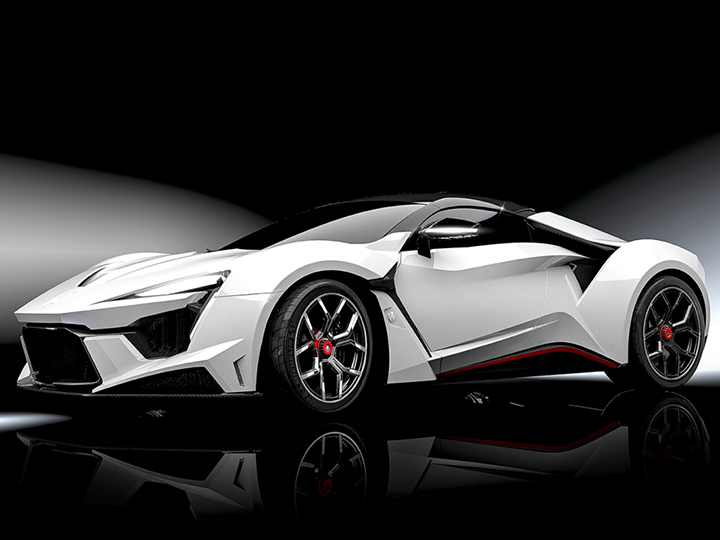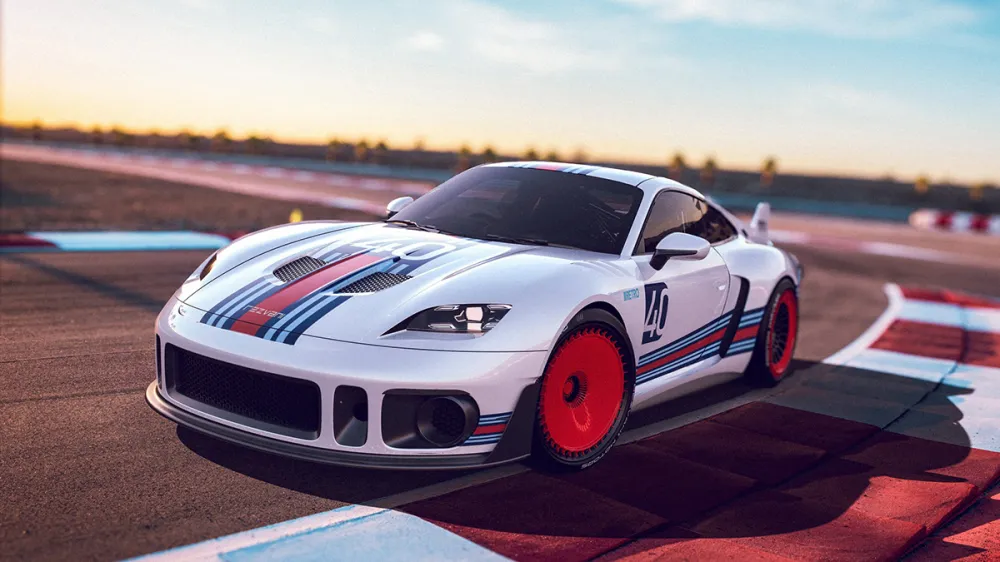
Six stunning supercars that fly under the radar
A growing number of boutique builders are accelerating out of the shadows and presenting boundary-breaking design, engineering, and performance.
Related articles
Marques such as McLaren, Lamborghini, and Bugatti are synonymous with supercars, and rightly so. These icons of innovation repeatedly set new benchmarks in all areas of the industry, and continue to fine-tune the template of exclusivity for others to follow — and follow they are.
A growing number of boutique builders are accelerating out of the shadows and creating their own automotive machinations — each presenting boundary-breaking design, engineering, and performance. The examples here, rolling in the seven-figure price range, may lack name recognition, but they will certainly give their market segment some souped-up competition.
## Boreas

Named for the mythological Greek god of the north wind, the Boreas — from Spain’s DSD Design & Motorsport — is two-door tempest touting a mostly carbon-fibre monocoque construction and a proprietary hybrid power train that generates more than 745 kW. The latter, which also includes a 7-speed automated manual transmission, allows the brute to blow from zero to 100 km/h in 2.8 seconds and reach a top speed of 380 km/h.
“The Boreas project arose from the ambition to strive for technical and aesthetic innovation,” says DSD founder David Sancho Domingo. “We were also focused on the search for ergonomics within the varying physical and psychological scales that would be experienced.”
Prior to beginning Boreas, Domingo educated himself on the intricacies of supercar construction by journeying throughout Europe and the United States to personally meet with marques that specialise in high-performance vehicles — such as Pagani and Shelby, among others — and tour their facilities. The fact-finding foray helped him decipher the direction he and his team would take in the hope of making an indelible impression on the industry.
After 10 years in development, a standing model of Domingo’s own automotive dynamo was introduced at France’s 24 Hours of Le Mans endurance race last June, followed by a completed prototype shortly thereafter. And while the Boreas is a one-off, 12 individually designed successors are planned for production in January.
## ZeroUno

‘It wasn’t an architect or a designer that invented objects, but an artisan.”
— Giorgetto Giugiaro
Although founder Giorgetto Giugiaro — named Car Designer of the Century in 1999 — is no longer with the firm, Italdesign has not only kept its purpose-driven passion, but increased the intensity. Acclaimed for the automotive artistry it has produced for others in the industry, the Torino-based team has finally stepped in front of the creative curtain to reveal its own masterwork — the ZeroUno supercar.
“The only way to design a successful sports car is to use the form-follows-function approach,” says Filippo Perini, head of design for Italdesign and the man responsible for the look of the Lamborghini Aventador. “For the ZeroUno project, we communicated a design language that fits with our company’s DNA, and we employed a simultaneous engineering process.”
Badged under the nearly 50-year-old firm’s new brand, Italdesign Automobili Speciali, the arrow-like automobile was presented in full force to the United States market at the 2017 Pebble Beach Concours d’Elegance on August 20. It was soon clear from its premiere that the car would be a crowd-pleaser in California.
And it’s no surprise, as the four-wheel-drive coupe’s appearance is as compelling as its performance. Built from a chassis constructed of carbon fibre and aluminum, and covered in a completely carbon-fibre body, the car carries a 455 kW, 5.2-litre naturally aspirated V10 engine (with 560 Nm) mated with a paddle-shift-activated dual-clutch 7-speed gearbox.
The power train enables the ZeroUno to zip from stationary to 100 km/h in 3.2 seconds and zoom up to 330 km/h. The car’s efficiency in motion is enhanced by an air-slicing aesthetic. “The ZeroUno has more in common with Italian GTs of the 1960’s,” explains Perini. “It’s a mix of soft, clean surfaces for the main body and extremely functional aerodynamic elements.”
The ZeroUno rolls with a starting price of US$1.7 ($A2.1) million. And seeing how well it fits in with the Golden State’s penchant for power and panache, one can only wonder if a sibling convertible is inevitable.
## Fenyr SuperSport

Based in the United Arab Emirates, W Motors introduced the Fenyr SuperSport to the world in 2015 at the Dubai International Motors Show. Named after a mythological wolf, the carbon-fibre ferocity, with a tubular aluminum chassis, has fangs in the form of a 4-litre twin-turbo flat-6 engine (built by Germany’s RUF Automobile) that nets 670 kW and 1,200 Nm. And with a 7-speed, double-clutch gearbox as part of the power train, the car clocks zero to 100 km/h in 2.7 seconds and can cruise at up to 400 km/h. With only 25 examples planned per year, each one will be priced at approximately US$1.85 ($A2.36) million.
## Lykan HyperSport

Another leader of the supercar pack is the Lykan HyperSport, also by W Motors. Debuted at the Qatar Motor Show in 2013, the ground-breaking coupe features diamond-encrusted headlights, reverse-dihedral doors, holographic instrumentation, and gold-stitched seats. Referencing the Greek word for “werewolf,” the Lykan lunges from zero to 100 km/h in 2.8 seconds and can give chase at up to 386 km/h thanks to its 580 kW, 3.7-litre flat-6 engine (producing 960 Nm). These performance characteristics, along with a distinct body design and a price tag of US$3.4 ($A4.3) million, earned it a starring role in the 2015 film Furious 7. Coincidentally, only seven bespoke examples are planned for production.
## Fittipaldi EF7 Vision Gran Turismo

With a pedigree that comprises three pillars of the motorsports industry, the Fittipaldi EF7 Vision Gran Turismo by Pininfarina can’t help but be a top contender on the track. Presented at the 2017 Qatar Motor Show (April 18 through 22), the car is the collaborative creation of Brazil’s famed wheelman Emerson Fittipaldi, Italy’s premier coachbuilder Pininfarina, and Germany’s elite engineering team at HWA AG — a winning recipe for racing.
The composite coupe relies on carbon-fibre monocoque construction and carries a naturally aspirated V8 engine mated with an integrated gearbox. The power train, suspension, and braking system have been developed by HWA AG but are housed in a body that is distinctly Pininfarina in design. With its shark-like aesthetic, the automobile presents the same visual cues as its aquatic counterpart — an intimidating form that is strikingly streamline. But that is to be expected since the car’s eponymous racer was an apex predator in competition.
Fittipaldi was a dominant force during the decade of his Formula 1 career and won his first F1 Drivers’ Championship in 1972 at the age of 25, the youngest, at the time, to do so. And he is also the only driver to win the Indianapolis 500 and F1 Championship on multiple occasions, reason enough for his induction into the Motorsports Hall of Fame of America in 2001.
Upon purchase of a limited-edition example, aspiring racers will also be buying themselves a personal coaching session with the legend and eligibility for membership in the Fittipaldi Racing Club, host of global driving events. But those who steer toward more vicarious forms of vehicular contest will soon have their chance behind the wheel as well. A virtual version of the car will star in the latest release of Polyphony Digital’s popular Gran Tursimo game series and its interactive FIA Gran Turismo Championships.
## Pagani Huayra BC

Introduced at the Geneva International Motor Show in 2016 as a US$2.5 ($A3.1) million variant to Pagani’s original Huarya coupe, the BC (named in honour of Horacio Pagani’s close friend Benny Caiola) features the Italian marque’s carbon-titanium monocoque construction for the chassis and an enhanced 560 kW, twin-turbo Mercedes-Benz AMG V12 engine that turns out more than 560 kW and is exclusive to Pagani. Mated to that muscle is a bespoke 7-speed automated manual transmission (AMT) that features Xtrac’s new electro-hydraulic actuation for faster and more precise shifting. Other innovations on board include Bosch’s antilock braking system, traction control, and electronic stability program.
Subscribe to the Newsletter
Recommended for you
8 Fascinating Facts You Didn’t Know About Aston Martin
The British sports car company is most famous as the vehicle of choice for James Bond, but Aston Martin has an interesting history beyond 007.
May 1, 2024
Rezvani Will Rebuild Your 911 to Go From Zero to 100 in Two Seconds
The shop will build a version of the RR1 based on the Carrera S, GT3, and Turbo S
By Bryan Hood
April 23, 2024
You may also like.
You may also like.
Watch of the Week: TAG Heuer Formula 1 | Kith
The legendary sports watch returns, but with an unexpected twist.
Over the last few years, watch pundits have predicted the return of the eccentric TAG Heuer Formula 1, in some shape or form. It was all but confirmed when TAG Heuer’s heritage director, Nicholas Biebuyck, teased a slew of vintage models on his Instagram account in the aftermath of last year’s Watches & Wonders 2023 in Geneva. And when speaking with Frédéric Arnault at last year’s trade fair, the former CEO asked me directly if the brand were to relaunch its legacy Formula 1 collection, loved by collectors globally, how should they go about it?
My answer to the baited entreaty definitely didn’t mention a collaboration with Ronnie Fieg of Kith, one of the world’s biggest streetwear fashion labels. Still, here we are: the TAG Heuer Formula 1 is officially back and as colourful as ever.
As the watch industry enters its hype era—in recent years, we’ve seen MoonSwatches, Scuba Fifty Fathoms, and John Mayer G-Shocks—the new Formula 1 x Kith collaboration might be the coolest yet.

Here’s the lowdown: overnight, TAG Heuer, together with Kith, took to socials to unveil a special, limited-edition collection of Formula 1 timepieces, inspired by the original collection from the 1980s. There are 10 new watches, all limited, with some designed on a stainless steel bracelet and some on an upgraded rubber strap; both options nod to the originals.
Seven are exclusive to Kith and its global stores (New York, Los Angeles, Miami, Hawaii, Tokyo, Toronto, and Paris, to be specific), and are made in an abundance of colours. Two are exclusive to TAG Heuer; and one is “shared” between TAG Heuer and Kith—this is a highlight of the collection, in our opinion. A faithful play on the original composite quartz watch from 1986, this model, limited to just 1,350 pieces globally, features the classic black bezel with red accents, a stainless steel bracelet, and that creamy eggshell dial, in all of its vintage-inspired glory. There’s no doubt that this particular model will present as pure nostalgia for those old enough to remember when the original TAG Heuer Formula 1 made its debut.

Of course, throughout the collection, Fieg’s design cues are punctuated: the “TAG” is replaced with “Kith,” forming a contentious new brand name for this specific release, as well as Kith’s slogan, “Just Us.”
Collectors and purists alike will appreciate the dedication to the original Formula 1 collection: features like the 35mm Arnite cases—sourced from the original 80s-era supplier—the form hour hand, a triangle with a dot inside at 12 o’clock, indices that alternate every quarter between shields and dots, and a contrasting minuterie, are all welcomed design specs that make this collaboration so great.
Every TAG Heuer Formula 1 | Kith timepiece will be presented in an eye-catching box that complements the fun and colour theme of Formula 1 but drives home the premium status of this collaboration. On that note, at $2,200 a piece, this isn’t exactly an approachable quartz watch but reflects the exclusive nature of Fieg’s Kith brand and the pieces he designs (largely limited-edition).

So, what do we think? It’s important not to understate the significance of the arrival of the TAG Heuer Formula 1 in 1986, in what would prove integral in setting up the brand for success throughout the 90’s—it was the very first watch collection to have “TAG Heuer” branding, after all—but also in helping to establish a new generation of watch consumer. Like Fieg, many millennial enthusiasts will recall their sentimental ties with the Formula 1, often their first timepiece in their horological journey.
This is as faithful of a reissue as we’ll get from TAG Heuer right now, and budding watch fans should be pleased with the result. To TAG Heuer’s credit, a great deal of research has gone into perfecting and replicating this iconic collection’s proportions, materials, and aesthetic for the modern-day consumer. Sure, it would have been nice to see a full lume dial, a distinguishing feature on some of the original pieces—why this wasn’t done is lost on me—and perhaps a more approachable price point, but there’s no doubt these will become an instant hit in the days to come.
—
The TAG Heuer Formula 1 | Kith collection will be available on Friday, May 3rd, exclusively in-store at select TAG Heuer and Kith locations in Miami, and available starting Monday, May 6th, at select TAG Heuer boutiques, all Kith shops, and online at Kith.com. To see the full collection, visit tagheuer.com
You may also like.
8 Fascinating Facts You Didn’t Know About Aston Martin
The British sports car company is most famous as the vehicle of choice for James Bond, but Aston Martin has an interesting history beyond 007.
Aston Martin will forever be associated with James Bond, ever since everyone’s favourite spy took delivery of his signature silver DB5 in the 1964 film Goldfinger. But there’s a lot more to the history of this famed British sports car brand beyond its association with the fictional British Secret Service agent.
Let’s dive into the long and colourful history of Aston Martin.
You may also like.
What Venice’s New Tourist Tax Means for Your Next Trip
The Italian city will now charge visitors an entry fee during peak season.
Visiting the Floating City just got a bit more expensive.
Venice is officially the first metropolis in the world to start implementing a day-trip fee in an effort to help the Italian hot spot combat overtourism during peak season, The Associated Press reported. The new program, which went into effect, requires travellers to cough up roughly €5 (about $AUD8.50) per person before they can explore the city’s canals and historic sites. Back in January, Venice also announced that starting in June, it would cap the size of tourist groups to 25 people and prohibit loudspeakers in the city centre and the islands of Murano, Burano, and Torcello.
“We need to find a new balance between the tourists and residents,’ Simone Venturini, the city’s top tourism official, told AP News. “We need to safeguard the spaces of the residents, of course, and we need to discourage the arrival of day-trippers on some particular days.”
During this trial phase, the fee only applies to the 29 days deemed the busiest—between April 25 and July 14—and tickets will remain valid from 8:30 am to 4 pm. Visitors under 14 years of age will be allowed in free of charge in addition to guests with hotel reservations. However, the latter must apply online beforehand to request an exemption. Day-trippers can also pre-pay for tickets online via the city’s official tourism site or snap them up in person at the Santa Lucia train station.
“With courage and great humility, we are introducing this system because we want to give a future to Venice and leave this heritage of humanity to future generations,” Venice Mayor Luigi Brugnaro said in a statement on X (formerly known as Twitter) regarding the city’s much-talked-about entry fee.
Despite the mayor’s backing, it’s apparent that residents weren’t totally pleased with the program. The regulation led to protests and riots outside of the train station, The Independent reported. “We are against this measure because it will do nothing to stop overtourism,” resident Cristina Romieri told the outlet. “Moreover, it is such a complex regulation with so many exceptions that it will also be difficult to enforce it.”
While Venice is the first city to carry out the new day-tripper fee, several other European locales have introduced or raised tourist taxes to fend off large crowds and boost the local economy. Most recently, Barcelona increased its city-wide tourist tax. Similarly, you’ll have to pay an extra “climate crisis resilience” tax if you plan on visiting Greece that will fund the country’s disaster recovery projects.
You may also like.
Omega Reveals a New Speedmaster Ahead of the Paris 2024 Olympics
Your first look at the new Speedmaster Chronoscope, designed in the colour theme of the Paris Olympics.
The starters are on the blocks, and with less than 100 days to go until the Paris 2024 Olympics, luxury Swiss watchmaker Omega was bound to release something spectacular to mark its bragging rights as the official timekeeper for the Summer Games. Enter the new 43mm Speedmaster Chronoscope, available in new colourways—gold, black, and white—in line with the colour theme of the Olympic Games in Paris this July.
So, what do we get in this nicely-wrapped, Olympics-inspired package? Technically, there are four new podium-worthy iterations of the iconic Speedmaster.

The new versions present handsomely in stainless steel or 18K Moonshine Gold—the brand’s proprietary yellow gold known for its enduring shine. The steel version has an anodised aluminium bezel and a stainless steel bracelet or vintage-inspired perforated leather strap. The Moonshine Gold iteration boasts a ceramic bezel; it will most likely appease Speedy collectors, particularly those with an affinity for Omega’s long-standing role as stewards of the Olympic Games.
Notably, each watch bears an attractive white opaline dial; the background to three dark grey timing scales in a 1940s “snail” design. Of course, this Speedmaster Chronoscope is special in its own right. For the most part, the overall look of the Speedmaster has remained true to its 1957 origins. This Speedmaster, however, adopts Omega’s Chronoscope design from 2021, including the storied tachymeter scale, along with a telemeter, and pulsometer scale—essentially, three different measurements on the wrist.
While the technical nature of this timepiece won’t interest some, others will revel in its theatrics. Turn over each timepiece, and instead of a transparent crystal caseback, there is a stamped medallion featuring a mirror-polished Paris 2024 logo, along with “Paris 2024” and the Olympic Rings—a subtle nod to this year’s games.
Powering this Olympiad offering—and ensuring the greatest level of accuracy—is the Co-Axial Master Chronometer Calibre 9908 and 9909, certified by METAS.

A Speedmaster to commemorate the Olympic Games was as sure a bet as Mondo Deplantis winning gold in the men’s pole vault—especially after Omega revealed its Olympic-edition Seamaster Diver 300m “Paris 2024” last year—but they delivered a great addition to the legacy collection, without gimmickry.
However, the all-gold Speedmaster is 85K at the top end of the scale, which is a lot of money for a watch of this stature. By comparison, the immaculate Speedmaster Moonshine gold with a sun-brushed green PVD “step” dial is 15K cheaper, albeit without the Chronoscope complications.
—
The Omega Speedmaster Chronoscope in stainless steel with a leather strap is priced at $15,725; stainless steel with steel bracelet at $16,275; 18k Moonshine Gold on leather strap $54,325; and 18k Moonshine Gold with matching gold bracelet $85,350, available at Omega boutiques now.
Discover the collection here
You may also like.
Here’s What Goes Into Making Jay-Z’s $1,800 Champagne
We put Armand de Brignac Blanc de Noirs Assemblage No. 4 under the microsope.
In our quest to locate the most exclusive and exciting wines for our readers, we usually ask the question, “How many bottles of this were made?” Often, we get a general response based on an annual average, although many Champagne houses simply respond, “We do not wish to communicate our quantities.” As far as we’re concerned, that’s pretty much like pleading the Fifth on the witness stand; yes, you’re not incriminating yourself, but anyone paying attention knows you’re probably guilty of something. In the case of some Champagne houses, that something is making a whole lot of bottles—millions of them—while creating an illusion of rarity.
We received the exact opposite reply regarding Armand de Brignac Blanc de Noirs Assemblage No. 4. Yasmin Allen, the company’s president and CEO, told us only 7,328 bottles would be released of this Pinot Noir offering. It’s good to know that with a sticker price of around $1,800, it’s highly limited, but it still makes one wonder what’s so exceptional about it.
Known by its nickname, Ace of Spades, for its distinctive and decorative metallic packaging, Armand de Brignac is owned by Louis Vuitton Moët Hennessy and Jay-Z and is produced by Champagne Cattier. Each bottle of Assemblage No. 4 is numbered; a small plate on the back reads “Assemblage Four, [X,XXX]/7,328, Disgorged: 20 April, 2023.” Prior to disgorgement, it spent seven years in the bottle on lees after primary fermentation mostly in stainless steel with a small amount in concrete. That’s the longest of the house’s Champagnes spent on the lees, but Allen says the winemaking team tasted along the way and would have disgorged earlier than planned if they’d felt the time was right.
Chef de cave, Alexandre Cattier, says the wine is sourced from some of the best Premier and Grand Cru Pinot Noir–producing villages in the Champagne region, including Chigny-les-Roses, Verzenay, Rilly-la-Montagne, Verzy, Ludes, Mailly-Champagne, and Ville-sur-Arce in the Aube département. This is considered a multi-vintage expression, using wine from a consecutive trio of vintages—2013, 2014, and 2015—to create an “intense and rich” blend. Seventy percent of the offering is from 2015 (hailed as one of the finest vintages in recent memory), with 15 percent each from the other two years.

This precisely crafted Champagne uses only the tête de cuvée juice, a highly selective extraction process. As Allen points out, “the winemakers solely take the first and freshest portion of the gentle cuvée grape press,” which assures that the finished wine will be the highest quality. Armand de Brignac used grapes from various sites and three different vintages so the final product would reflect the house signature style. This is the fourth release in a series that began with Assemblage No. 1. “Testing different levels of intensity of aromas with the balance of red and dark fruits has been a guiding principle between the Blanc de Noirs that followed,” Allen explains.
The CEO recommends allowing the Assemblage No. 4 to linger in your glass for a while, telling us, “Your palette will go on a journey, evolving from one incredible aroma to the next as the wine warms in your glass where it will open up to an extraordinary length.” We found it to have a gorgeous bouquet of raspberry and Mission fig with hints of river rock; as it opened, notes of toasted almond and just-baked brioche became noticeable. With striking acidity and a vein of minerality, it has luscious nectarine, passion fruit, candied orange peel, and red plum flavors with touches of beeswax and a whiff of baking spices on the enduring finish. We enjoyed our bottle with a roast chicken rubbed with butter and herbes de Provence and savored the final, extremely rare sip with a bit of Stilton. Unfortunately, the pairing possibilities are not infinite with this release; there are only 7,327 more ways to enjoy yours.


























